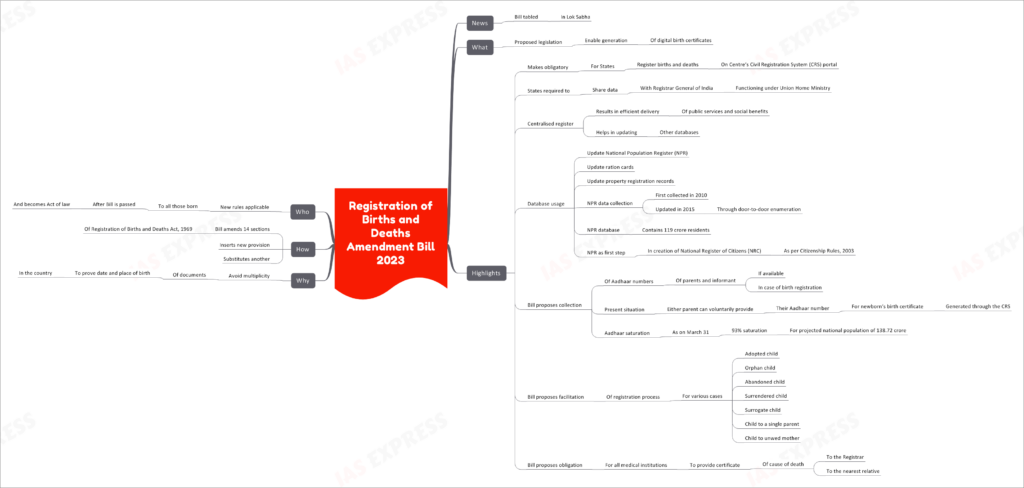[Newsbits] 26.07.2023

RoboMapper
News
- A report in the journal 'Matter' highlights RoboMapper's efficient material testing capabilities.
What
- RoboMapper is a new robot technology designed for material testing.
Pros
- The technology is more efficient, resulting in faster material testing.
- It is sustainable and contributes to reducing greenhouse gas (GHG) emissions by 10 times compared to conventional methods.
How
- RoboMapper is presented with a set of materials and tasked with developing alloys using them.
- The robot creates different combinations of materials and runs various tests to determine:
- If they have a Crystalline structure of perovskite.
- Their desirable set of optical characteristics, known as the band gap.
- Their stability when exposed to intense light.
Applications
- RoboMapper is particularly useful in identifying perovskite materials that exhibit better stability and efficiency for use in solar cells. This can have significant implications for the development of more efficient and sustainable solar energy technologies.
Civil Liability for Nuclear Damage Act
- A written reply about the Civil Liability for Nuclear Damage Act was given in Lok Sabha.
What
- The Civil Liability for Nuclear Damage Act is legislation that deals with civil liability for nuclear damage and ensures prompt compensation to victims of nuclear incidents through a no-fault liability regime.
Highlights
- The Act provides for civil liability for nuclear damage, and the liability is channeled to the operator of the nuclear facility.
- Operators of nuclear facilities are required to maintain insurance or financial securities, or a combination of both, to cover their liability in case of a nuclear incident. They must also renew these insurance policies or financial securities periodically.
- The liability of the operator for each nuclear incident is based on the type of facility and power output. For example:
- Nuclear reactors with thermal power equal to or above ten MW have a liability of 1500 crores.
- Spent fuel reprocessing plants have a liability of 300 crores.
- Research reactors, fuel cycle facilities, and transportation of nuclear materials with thermal power below ten MW have a liability of 100 crores.
- The India Nuclear Insurance Pool (INIP) was established to provide insurance to cover the liability of operators.
- The Central Government has the authority to review the operator's liability and may specify a higher amount for compensation if necessary.
- The Act adheres to the Convention on Supplementary Compensation (CSC), which offers a two-tier system for the amount of compensation.
- The Act places no-fault liability on operators but also gives them a right of recourse against certain persons.
- The operator's liability is capped at 500 crore. For damage exceeding this amount and up to 300 million SDR, the central government will be liable.
- All operators (except the central government) need to take insurance or provide financial security to cover their liability.
- For government-owned facilities, the entire liability up to 300 million SDR will be borne by the government.
- The Act specifies who can claim compensation and designates the authorities responsible for assessing and awarding compensation for nuclear damage.
- Non-compliance with the provisions of the Act can result in penalties.
When
- The Civil Liability for Nuclear Damage Act was enacted in 2010.
Kargil Vijay Diwas 2023
News
- The 2023 Kargil Vijay Diwas was observed, marking the 24th anniversary of the Kargil War.
What
- Kargil Vijay Diwas is an annual celebration dedicated to honoring the soldiers who fought in the 1999 Kargil War, also known as the Kargil Conflict.
- The Kargil War was the last war between two South Asian neighbors, India and Pakistan. It took place between May and July 1999 and occurred along the Line of Control.
- The conflict was initiated by Pakistani infiltration, which was in violation of the 1972 Shimla Agreement.
Commemorates India's Victory
- Kargil Vijay Diwas commemorates India's victory in "Operation Vijay," a military operation carried out by India against Pakistan.
- During Operation Vijay, Indian troops successfully evicted enemy troops from strategic locations, including Tiger Hill and several other important positions.
When
- Kargil Vijay Diwas is observed annually on July 26th.
Han Kuang Drills
News
- Taiwan staged military drills for the first time at Taoyuan International Airport, the country's largest airport, defending against a simulated attack by China.
What
- The name "Han Kuang" translates to "Han Glory."
- The drills are a week-long war exercise held annually, with the 39th edition taking place in 2023.
Why
- The drills are conducted to test Taiwan's combat readiness in the face of a possible Chinese invasion.
How
- The Han Kuang drills consist of live fire exercises and computerized war games.
Who
- The drills involve all branches of Taiwan's military.
When
- The Han Kuang drills have been held annually since 1984.
Japanese Population Decline
News
- Japan records the steepest population decline, marking the 14th consecutive year of decline.
Highlights
- The Japanese population has been declining since its peak in 2008, largely attributed to a declining birthrate.
- Last year, there were only 771,801 births recorded, which is a record low.
- The number of Japanese nationals declined by 0.65%, equivalent to 800,000 people, bringing the total population to 122.4 million in 2022 compared to the previous year.
- Population decline was observed in all 47 prefectures for the first time.
- On the other hand, the number of foreign residents reached a new high of 3 million people, accounting for 2.4% of the total population.
Significance
- The declining Japanese population and the increasing number of foreign residents reflect the changing dynamics and the role played by non-Japanese individuals in an aging and shrinking Japan.
Who
- The data on the Japanese population decline comes from the Internal Affairs and Communications Ministry.
Facts
- In response to the shrinking population, the Japanese cabinet approved a plan to expand job categories allowed for foreign workers, potentially opening the door for future permanent residency.
- This represents a major shift in the country, which has been historically known for its closed-door immigration policy and is now grappling with the challenges posed by a declining population.
Hattee Community
News
- Rajya Sabha passed the Constitution (Scheduled Tribes) Order (Third Amendment) Bill 2022, according Scheduled Tribe status to the Hattee Community.
Who
- The Hattee Community is named after its traditional occupation, which involves selling home-grown crops, vegetables, meat, and wool at small-town markets known as 'haats.'
- The community consists of approximately 3 lakh members.
Where
- They are settled in the Sirmour district of Himachal Pradesh.
When
- The demand for Scheduled Tribe status for the Hattee Community has been persistent since 1967.
Registration of Births and Deaths (RBD) Amendment Bill, 2023
The Registration of Births and Deaths (RBD) Amendment Bill, 2023 has been tabled in Lok Sabha as a proposed legislation.
What
- The proposed legislation aims to enable the generation of digital birth certificates through the CRS system.
Highlights
Centralized Registration System
- The bill mandates all states to register births and deaths on the Centre's Civil Registration System (CRS) portal.
- States are required to share data with the Registrar General of India, which functions under the Union Home Ministry.
- This centralized register is expected to lead to efficient delivery of public services and social benefits.
- The CRS database will also be used to update other important databases, including the National Population Register (NPR), ration cards, and property registration records.
National Population Register (NPR)
- The NPR data was first collected in 2010 and updated in 2015 through door-to-door enumeration.
- The NPR database currently contains information on 119 crore residents.
- The NPR is considered the first step in the creation of the National Register of Citizens (NRC) as per Citizenship Rules, 2003.
Collection of Aadhaar Numbers
- The bill proposes the collection of Aadhaar numbers of parents and informants, if available, during birth registration.
- Currently, either parent can voluntarily provide their Aadhaar number for the newborn's birth certificate generated through the CRS.
- As of March 31, Aadhaar saturation stands at 93% for the projected national population of 138.72 crore.
Facilitation of Registration Process
- The bill proposes to facilitate the registration process for various cases, including adopted, orphaned, abandoned, surrendered, surrogate, and children of single parents or unwed mothers.
Obligation for Medical Institutions
- The bill places an obligation on all medical institutions to provide certificates of the cause of death to the Registrar and the nearest relative.
Why
- The primary objective of the bill is to avoid the multiplicity of documents needed to prove the date and place of birth in the country.
How
- The bill amends 14 sections of the Registration of Births and Deaths Act, 1969.
- It introduces new provisions and substitutes existing ones to streamline the registration process.
Who
- The new rules introduced by the bill will be applicable to all individuals born after the Bill is passed and becomes an Act of law.







